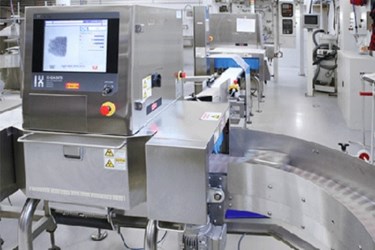What To Consider When Considering X-Ray Inspection Systems
By Isaac Fletcher, contributing writer, Food Online

X-Ray inspection provides food manufacturers with a wide range of benefits, such as risk management, quality assurance, and improved food safety. All of these capabilities result in a higher-quality product and a sharpened competitive edge
How The System Functions
First, it’s important to understand how these inspection systems work. The inspection system works by shooting an X-Ray beam through the product being inspected. On the other side of the product, a photodiode array picks up the radiation that passes through and is used to create a grayscale X-Ray image of the product. If there are inclusions that are denser than the product itself, they will show up in the image as dark spots, as less X-Ray radiation is able to pass through those areas. Voids and empty spaces will appear lighter.
X-Ray Inspection Capabilities
X-Ray inspection systems are capable of detecting inconsistencies in materials during production. For example, the systems can detect fragments of bone, stone, glass, metal, and even some plastics. Aside from the ability to detect foreign bodies in materials, X-Ray inspection systems can easily spot areas where products may be broken or have missing pieces, which helps streamline the quality control process. Additionally, the systems can be used as a method for measuring the fat content of meat or providing information on product weight.
Learn why one food maker implemented the next generation of X-Ray inspection systems
These capabilities can help manufacturers detect problems in the production phase and identify potential issues that need to be corrected. Ultimately, X-Ray inspection systems have not only expanded the parameters that can be checked, but also increased the speed at which inspection takes place. A higher rate of imperfection detection will result in a product of superior quality, which can give manufacturers a competitive edge.
A Risk Management Tool
To properly manage risk, managers and decision-makers need to make accurate assessments of what could go wrong, the effects of something going wrong, and the impact of any consequences, such as costs. Members of the food industry are constantly aware of the legislations and regulations that govern operations and production. When it comes to food safety and effective food inspection, food manufacturers can benefit greatly from implementing X-Ray inspection systems to catch and remove flawed products before they ever reach the end consumer.
The Cost Of Not Implementing X-Ray Detection
The presence of foreign bodies in food products can have a wide range of impact — from minor disapproval to serious health hazards. Even if there is no harm resulting from a foreign body being discovered in a good product, this occurrence can quickly lead to a loss of trust and the degradation of consumer confidence in the brand. Although foreign bodies may be detected by the retailer before a product may ever reach a consumer, this can still result in unwarranted — and unwelcome — costs to the supplier. The consequences of such can include returned inventory, fines, and loss of contracts.
Lower The Cost Of Ownership For Product Inspection While Improving Quality
Aside from adverse consumer and retailer effects, not using an X-Ray inspection system can open the door to unfounded lawsuits. For example, in the event that a consumer claims they have discovered a foreign body within a product, a manufacturer that uses an X-Ray inspection system has the ability to go into the data systems and retrieve the X-Ray image of that exact pack and determine beyond any doubt whether or not a foreign body was actually present in the product at the time it left the manufacturing facility.
